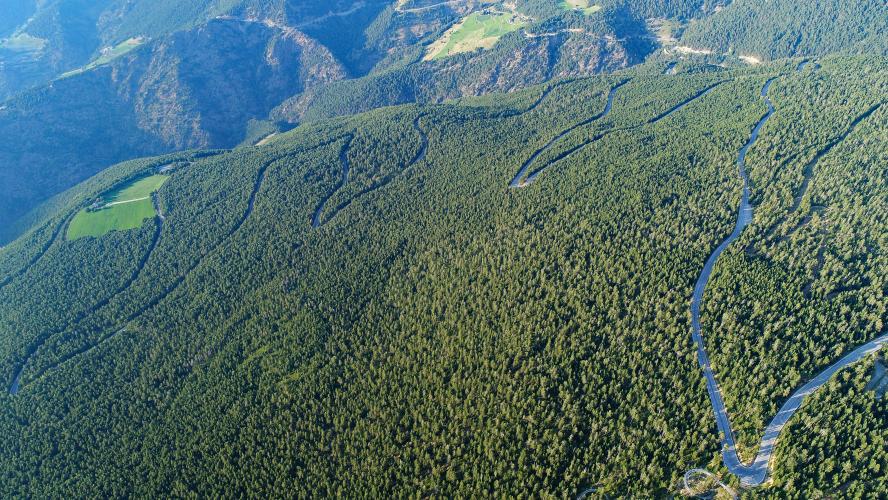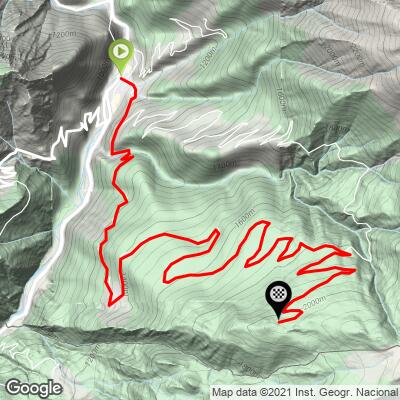![Summit Sign Cycling La Rabassa by road bike - summit sign]()
La Rabassa Summit sign
This is one of the longer and tougher climbs in Andorra. La Rabassa is 17 kilometers, averaging 6.5% and gaining 1,123 meters in all. One kilometer averages 11.4% beginning at km 2.6 which is very challenging. The majority of the climb is surrounded by a thick and impenetrable forest which blocks most views. The primary break in the forest comes for 800 meters beginning at km 4.4 as we pass through the small Andorran parish of Juberri.
![Statues in Juberi Climb by bike in Andorra - statues in Juberi]()
Juberri at km 4.4
![Ctra de la Rabassa Drone photo of Ctra de la Rabassa ,Sant Julià de Lòria, Andorra]()
Thick forest borders the road most of the climb.
Other than this magnificent climb, the main attraction in this area is Naturlandia which we pass at km 8.
“Imagine an adventure park in Andorra with thrilling rides for all ages, a stunning natural setting and the chance to see large native Pyrenean animals! All this and much more is to be found at Naturlandia. This leisure park in the parish of Sant Julià de Lòria is one of the most enticing offers for those looking to mix family and active tourism.
The park covers 800 hectares in the middle of a forest in the La Rabassa area, divided into two spaces. One is at 1,600 m above sea level, where the esplanade with the main rides is to be found. The other is 2,000 m above sea level, where you'll find the starting point for some of the circuits and the animal park. The park is open every day of the year, with activities adapted for both the winter and summer seasons.” VisitAndorra.com - Naturlandia
The Vuelta a España has featured La Rabassa on at least 5 occasions since 2000, most recently as stage 3 in 2017 as of July 2018 when we visited Andorra to climb this and other cimbs in the area (Chris Froome took the red jersey on this mountainous stage of which La Rabassa was the penultimate col[1]).
The Vuelta a España visits Andorra for 2 days in 2018:
“The Vuelta a España is an old acquaintance of Andorra, which has been the setting for some thrilling stages. With the epic stage held in our country in September 2015 still fresh in fans' memories, this year we can once again experience the greatness of this sport.
On Friday 14 September, Naturlandia (height of 2,000 m) will host the finish of the 19th stage (Lleida-Andorra, 154.4 km). And on Saturday 15, the Principality of Andorra will be the setting for the 20th stage, which will be disputed entirely on our roads.
This is the last stage of the 73rd Vuelta, which starts at Escaldes-Engordany, covering 97.3 km and almost 4,000 m of accumulated ascent. Riders will have to overcome the passes of Coll de la Comella (twice), Coll de Beixalis (also twice), Coll d'Ordina and Coll de la Gallina to reach the Canolich Sanctuary, the site of the finishing line.
With cyclists who'll already have three weeks in the saddle covering 3,000 km, the Andorran stage will leave its mark on this year's Vuelta. A day that no fan will want to miss.
The race, one of the big three along with the Giro and the Tour, starts in Malaga on 25 August and ends in Madrid on 16 September. The 2018 Vuelta has 21 stages and covers 3,270 km. There will be a 40.7km individual time trial and 46 mountains passes, with two rest days.”
[1]In 2017 Chris Froome became only the third rider in history to win the Tour de France and Vuelta d Espana in the same year (legends Jacques Anquetil won both in 1963 and Bernard Hinault accomplished this extraordinary double in 1978.

 We've partnered with Sherpa-Map.com to bring you the best route planning tool. With a PRO Membership you can use this climb as a reference when creating your route.
We've partnered with Sherpa-Map.com to bring you the best route planning tool. With a PRO Membership you can use this climb as a reference when creating your route. 

